|
THE
PURSUIT OF TROPHY TROUT
(Or how to catch trout as big as your leg)
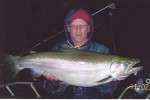 The
rod bounces hard from the strike and instantly your drag
is screaming. Yards of line are melting off as you wait
for the initial run to stop. You crank down a bit and lean
into it. The full arch in the rod confirms that this is
a big fish. A couple of pulsing, exaggerated headshakes
and you are off to the races again on the next run. Is it
a Marlin? Or, could it be a Striper? No, this is a giant
Gerrard Rainbow Trout pushing 20 lbs. These magnificent
fish are only found in Kootenai Lake, B.C. and Pend Oreille
Lake, Idaho and are the biggest land-locked rainbows in
the world. The
rod bounces hard from the strike and instantly your drag
is screaming. Yards of line are melting off as you wait
for the initial run to stop. You crank down a bit and lean
into it. The full arch in the rod confirms that this is
a big fish. A couple of pulsing, exaggerated headshakes
and you are off to the races again on the next run. Is it
a Marlin? Or, could it be a Striper? No, this is a giant
Gerrard Rainbow Trout pushing 20 lbs. These magnificent
fish are only found in Kootenai Lake, B.C. and Pend Oreille
Lake, Idaho and are the biggest land-locked rainbows in
the world.
I have fished
for 48 of my 53 years on this planet. As it goes for most
anglers, I would simply settle for catching a fish in the
beginning. Then it was how many can I catch? Soon I was
hunting certain species and finally, for me, it came down
to catching big fish. That is the evolution of fishing in
my life. To be even more specific, I enjoy spending a lot
of my time and way too much of my money chasing after trophy
trout. Every one who knows me knows this to be true. What
do I mean by trophy trout? By most people’s standards,
a 5 lb. trout would certainly qualify. To the circle of
fanatics I am referring to (myself included) the gold standard
would be more like the following: Brook trout over 5 lbs.,
Brown, Rainbow, Bull and Lahontan Cutthroat exceeding 10
lbs., and Mackinaws over 30 lbs., would all be considered
trophies. I will mention that Kokanee Salmon over 4 lbs.,
here in Oregon, would be considered trophies as well. There
are other species of trout here in the Western United States
but I am going to confine my discussion to the above species.
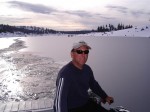 Let
me start by saying I believe that it takes three basic things
to become an accomplished trophy trout angler. These are
not necessarily in order but essential to being successful.
You must be determined, committed, and have a willingness
to learn. I know guys who think nothing of driving all night
to a lake hundreds of miles away. Most of us are willing
to sleep in our rigs if necessary and give up many creature
comforts to stick a real wall hanger. You should be prepared
to spend a large part of your free time to catch fish of
these proportions. Many trophy brown trout aficionados spend
years between big fish. This pursuit is not for the faint
hearted. Let
me start by saying I believe that it takes three basic things
to become an accomplished trophy trout angler. These are
not necessarily in order but essential to being successful.
You must be determined, committed, and have a willingness
to learn. I know guys who think nothing of driving all night
to a lake hundreds of miles away. Most of us are willing
to sleep in our rigs if necessary and give up many creature
comforts to stick a real wall hanger. You should be prepared
to spend a large part of your free time to catch fish of
these proportions. Many trophy brown trout aficionados spend
years between big fish. This pursuit is not for the faint
hearted.
I suggest as part of your game plan, that you learn as much
as you can about the species you are trying to catch. Understanding
feeding habits and types of forage are essential in helping
you to choose a lure that will put one of these monsters
in the boat. Almost all trout of this size are piscivorous
(eat other fish) and you will want to use lures that match
their natural forage. Knowing the preferred structure and
water temperatures will increase your odds tremendously.
For example, in the early spring at ice out, large brown
trout are often caught in the upper 20 feet of the water
column due to higher oxygenation and warmer water temperatures.
Likewise, in Lake Pend Oreille in Northern Idaho, giant
Gerrard rainbows are caught near the surface in the fall
right after the lake turns over and the temperatures (around
50 degrees) are desirable for them and the kokanee they
eat. Conversely, when we are fishing for large mackinaw
at Odell Lake in the summer, we target fish nearer the thermocline
and along the bottom with downriggers. Earlier in the year,
we can catch the macks as shallow as 20 feet. A little later
in the spring, when the water starts to warm up, we would
pursue those same fish with several lines stacked on downriggers
working a grid of water from 60 to 180 feet deep. Again,
the water temperatures and baitfish dictate where we look.
Large brown trout can be territorial and will stake out
an area that holds good structure (downed logs, boulders,
rocks or steep drop-offs) that give them a sense of security
and an ambush point as well. To the contrary, I have witnessed
browns working a school of kokanee pushed to the surface
in water 190 feet deep. The native rainbows of Upper Klamath
Lake tend to follow a migration pattern around the lake.
In the spring, they frequent the southern shores but as
the season progresses, they work their way around to the
mouth of the Williamson and Wood Rivers for the cooler,
oxygen rich water and their favorite forage (Tui Chub).
Learn the patterns of the fish on the water you are fishing
and make the necessary adjustments as conditions change
throughout the season.
 I
hope you understand that a boat is required to do the type
of fishing described above. I am talking about trolling
for these trophy fish because, with some exceptions, it
is probably the most effective way to catch them. I will
not go into what boat I think is best, but I was fortunate
enough to purchase an eighteen-foot Alumaweld Intruder last
year. Setting it up with good quality equipment like a Lowrance
X-15 graph, Scotty electric downriggers, and a Pro-Troll
black box gives me a leg up to get at those fish. A good
graph is essential to at least know the depth of water and
then of course to determine the location of fish and baitfish.
Everyone who has been in my boat and seen the X-15 in operation
has drooled over it, without exception. With the high pixel
count (480x350) in this model, the resolution is unreal.
I worked for Scotty downriggers last year and was a pro-staffer
before that, so I am quite familiar with their products.
I am a little prejudiced, but consider their downriggers
to be one of the best. For those of you who know nothing
or very little about “black boxes” (no, I am
not talking about the one on airplanes), they are one of
the latest “techno-tools” in fishing. Commercial
Salmon fishermen have used them successfully for over 30
years and they are now available to recreational anglers.
Dick Pool, owner of Pro-Troll products, has a good unit
that is in the $100 retail range. To learn more about it
go to www.protroll.com. The basic theory is this; every
boat is a battery and puts an electrical charge into the
water. With downriggers, that voltage is transmitted via
the stainless steel cables. That can be good or bad depending
on the amount of the voltage. Various studies have shown
that each species of fish prefers a certain percentage of
a volt and are attracted to it. The box gives you the ability
to control that voltage or “sweeten” the cable,
as I like to call it. I
hope you understand that a boat is required to do the type
of fishing described above. I am talking about trolling
for these trophy fish because, with some exceptions, it
is probably the most effective way to catch them. I will
not go into what boat I think is best, but I was fortunate
enough to purchase an eighteen-foot Alumaweld Intruder last
year. Setting it up with good quality equipment like a Lowrance
X-15 graph, Scotty electric downriggers, and a Pro-Troll
black box gives me a leg up to get at those fish. A good
graph is essential to at least know the depth of water and
then of course to determine the location of fish and baitfish.
Everyone who has been in my boat and seen the X-15 in operation
has drooled over it, without exception. With the high pixel
count (480x350) in this model, the resolution is unreal.
I worked for Scotty downriggers last year and was a pro-staffer
before that, so I am quite familiar with their products.
I am a little prejudiced, but consider their downriggers
to be one of the best. For those of you who know nothing
or very little about “black boxes” (no, I am
not talking about the one on airplanes), they are one of
the latest “techno-tools” in fishing. Commercial
Salmon fishermen have used them successfully for over 30
years and they are now available to recreational anglers.
Dick Pool, owner of Pro-Troll products, has a good unit
that is in the $100 retail range. To learn more about it
go to www.protroll.com. The basic theory is this; every
boat is a battery and puts an electrical charge into the
water. With downriggers, that voltage is transmitted via
the stainless steel cables. That can be good or bad depending
on the amount of the voltage. Various studies have shown
that each species of fish prefers a certain percentage of
a volt and are attracted to it. The box gives you the ability
to control that voltage or “sweeten” the cable,
as I like to call it.
One of the greatest developments in fishing equipment, in
my opinion, is the new braided lines. Their strength and
feel is unmatched when compared to monofilament lines. When
trolling, it is very important to know what is happening
with your lure 250 feet behind the boat. You can see the
action your lure telegraphs to the rod with a good braid.
It really comes in handy to determine if your lure has picked
up a small weed, something that is difficult with standard
monofilament. In a technique that some of us refer to as
rip-trolling or jigging, the rod is held and swept forward
and dropped back to simulate a wounded bait fish (deadly
on brown trout). With Braided line you can feel what the
lure is doing even 300 feet back. I can actually feel the
vibration of the lure through the rod. Again, this is rarely
possible with standard mono and its 30% stretch factor.
Without that stretch, you have greater hook setting ability
as well. I have found that Power-Pro line from Innovative
Textiles to be one of the best. The 30 lb. test has the
diameter of 8 lb. mono, which is another huge advantage
because of the amount of line you can load on your reel.
What I like to do is attach, via a uni-to-uni knot, 50 to
60 foot leaders (some prefer longer or shorter depending
on the species they are after and whether they are flatlining
versus downrigging) of a good monofilament or fluorocarbon
and finish with a cross lock snap. The snap allows for quick
and easy lure change outs and a lot of mobility in the lures
action (always make sure the snap is closed on both sides).
This combination gives me the strength and added feel of
the braid coupled with the stealthy invisibility and measured
stretch of the mono. In my opinion, this is a marriage made
in heaven. Load that line on a Shimano Calcutta 400 reel
attached to a Lamiglass or G.Loomis rod and you are ready
to roll. As you can see, I believe in top-end quality equipment.
It makes the fish-catching experience much more enjoyable
with less mechanical problems.
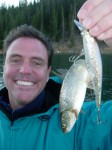 Lures
are probably the most important part of the puzzle. Appearance,
color, and action are all part of the attraction both for
the fish and for us. I believe that these big trout are
reacting out of hunger, irritation or agitation. I liken
the process of choosing a lure to that of “matching
the hatch” for fly fishermen. Again, I will state
the importance of knowing about the forage of the fish you
are after in that particular lake. Whether it is kokanee,
rainbows, tui chub, pond smelt, shiners, whitefish, shad
or whatever they feed on, try to represent them. Some anglers
go as far as to paint their own lures and go way beyond
the stock finishes. My favorite lure was the Excalibur Minnow
made by Pradco. Unfortunately, the lure is no longer in
production. I have caught more large browns (my best went
19 lbs. 6 oz.) on it than any lure I have ever used. One
of my best days of trophy trout fishing occurred in the
early spring a few years ago on a Central Oregon lake. I
ended up catching brown trout of 7, 8, 8.5 and 9 lbs. and
lake trout weighing 14 and 22 lbs. The only fish I kept
was the bigger laker, which now hangs on my wall. They were
all caught rip trolling an Excalibur Minnow in a suspending,
shad pattern model in twelve to twenty feet of water. I
believe this lure represented the kokanee in the lake and
I guess the trout did too. Lures
are probably the most important part of the puzzle. Appearance,
color, and action are all part of the attraction both for
the fish and for us. I believe that these big trout are
reacting out of hunger, irritation or agitation. I liken
the process of choosing a lure to that of “matching
the hatch” for fly fishermen. Again, I will state
the importance of knowing about the forage of the fish you
are after in that particular lake. Whether it is kokanee,
rainbows, tui chub, pond smelt, shiners, whitefish, shad
or whatever they feed on, try to represent them. Some anglers
go as far as to paint their own lures and go way beyond
the stock finishes. My favorite lure was the Excalibur Minnow
made by Pradco. Unfortunately, the lure is no longer in
production. I have caught more large browns (my best went
19 lbs. 6 oz.) on it than any lure I have ever used. One
of my best days of trophy trout fishing occurred in the
early spring a few years ago on a Central Oregon lake. I
ended up catching brown trout of 7, 8, 8.5 and 9 lbs. and
lake trout weighing 14 and 22 lbs. The only fish I kept
was the bigger laker, which now hangs on my wall. They were
all caught rip trolling an Excalibur Minnow in a suspending,
shad pattern model in twelve to twenty feet of water. I
believe this lure represented the kokanee in the lake and
I guess the trout did too.
At Pend Oreille
Lake in Northern Idaho, the Apex, produced by Hotspot, is
one of the standards and rank a close second only to specialty
trolling flies produced in that area. A 4.5 Apex produced
a line-class world record rainbow back in the early 90’s.
The fish was over 31 lbs. and caught on a guided trip under
Rich Reinwald when he was still running Trophy Trout Charters.
During my annual fall trips since 1990, I have caught 10
Gerrard rainbows from the “Pond” (slang the
locals use for Lake Pend Oreille) that went from 11 to 21
lbs. and friends with me accounted for another five between
10 and 19.5 lbs. All of them fell to Apexes. Several of
my friends and I have been using the Apexes for lake trout
with great success the last few years. Odell and Crescent
lakes in Oregon have turned out many big lakers for us up
to 29 lbs. in the last two years alone, while using them.
Here in Central
Oregon, where we can harvest one bull trout per day (over
24 in.) and only from Lake Billy Chinook, the Excalibur
Fat-Free Shad made by Pradco has turned out to be a sleeper
on big bulls. I was lucky enough to catch and release numerous
bull trout from 5 to 12 lbs. this last spring on these plugs.
I could go on for pages about all the different effective
lures that are out there, but the point I really want to
make is the value of learning about some of the lures that
work for the lake your fishing.
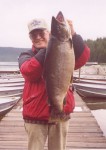 Lastly,
I would like to talk about a few of these die-hard anglers
and some of their accomplishments. I met Allan Cole a few
years ago when I joined a club that he started back in the
early 70’s. The “Brownbaggers” are a loose
knit group of anglers who have managed to catch at least
(2) brown trout exceeding 10 lbs. Several of the brownbaggers
have amassed incredible numbers over the years. Rich Reinwald
was a previous California State record holder for browns
and a very successful guide at Flaming Gorge Reservoir and
Lake Pend Oreille. Over the years he has caught (34) browns
over 10 lbs. and countless giant rainbows and mackinaw.
Many of the members I have talked with claim he is one of
the best anglers they have ever met. Lastly,
I would like to talk about a few of these die-hard anglers
and some of their accomplishments. I met Allan Cole a few
years ago when I joined a club that he started back in the
early 70’s. The “Brownbaggers” are a loose
knit group of anglers who have managed to catch at least
(2) brown trout exceeding 10 lbs. Several of the brownbaggers
have amassed incredible numbers over the years. Rich Reinwald
was a previous California State record holder for browns
and a very successful guide at Flaming Gorge Reservoir and
Lake Pend Oreille. Over the years he has caught (34) browns
over 10 lbs. and countless giant rainbows and mackinaw.
Many of the members I have talked with claim he is one of
the best anglers they have ever met.
Allan Cole,
founder of the Brownbaggers and lure inventor, caught his
26th brown over 10 lbs. while on a trip to a Central Oregon
lake this last Sept. All total, the group caught (4) browns
between 10 lbs. 4 oz. and 15 lbs. 9 oz., which are incredible
numbers to say the least. Allan invented the A/C lure, originally
marketed by the Fred Arbogast Co. and currently produced
by Luhr Jensen. Just recently, one of the handcrafted versions
of his plug accounted for a 28 lb. 5 oz. brown that now
stands as the new Oregon State record. Ron Lane caught the
fish at Paulina Lake on a 7 in. minnow model. This was Ron’s
“lucky” 13th brown over 10 and one, I am sure,
he will never forget.
My good friend
Ron Carey caught his 10th brown this last year from a lake
in Wyoming. The 13 lb. 14 oz. male broke a big fish drought
of several years and moved him up into the elite group with
10 browns over 10 lbs. Ron works for Wyoming Fish and Game
and is one of the few people I know who has released a brown
of 20 lbs., a fish he caught from a Colorado lake a couple
of years ago. One of his biggest browns was within ounces
of the Wyoming State record.
Jim Bringhurst,
during a trip to Paulina Lake earlier this last spring,
caught (2) browns in excess of 10 lbs. (that gives him 29
total) while relentlessly working the shoreline with the
jigging technique I described earlier in this article. Jim
is a pro-staffer for Berkley and is tenacious at working
for the big browns. His brother Bob was the previous World
Record holder with a giant brown that went 33 lbs. 10 oz.
from Flaming Gorge, Utah.
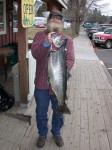 My
friend Chuck Jones, from Roseburg, Oregon, looks more like
a throw back to the “hippie days of the 60’s”
with his waist length, braided ponytail and full, gray beard.
Do not let his looks deceive you, he an accomplished trophy
trout angler. Chuck caught his 20th brown in excess of 10
lbs. this summer and to my knowledge, has probably caught
more than anyone has in the last few years. He has also
caught many nice mackinaw over 20 Lbs. and is legendary
for his salmon and steelhead success here in Southern Oregon. My
friend Chuck Jones, from Roseburg, Oregon, looks more like
a throw back to the “hippie days of the 60’s”
with his waist length, braided ponytail and full, gray beard.
Do not let his looks deceive you, he an accomplished trophy
trout angler. Chuck caught his 20th brown in excess of 10
lbs. this summer and to my knowledge, has probably caught
more than anyone has in the last few years. He has also
caught many nice mackinaw over 20 Lbs. and is legendary
for his salmon and steelhead success here in Southern Oregon.
Kim Daggett
has pioneered the art of downrigger fishing out west for
trophy browns. His Friend John Hofferd, previous resort
owner of East and Paulina Lakes, landed a 24 lb. brown at
Paulina a few years ago in Kim’s boat. In the summer
of 2000 during Aug. and Sept., Kim went on a spree of boating
several big browns over 10 lbs. for his guests and himself.
His best fish pushed 20 lbs. Kim was also a guide at Odell
Lake for mackinaw a few years ago.
I will finish
with two of my close friends here in Bend, fellow Scotty
pro-staffers, Terry Bennett and Steve Kroll. They are both
very proficient mackinaw anglers that I have had the privilege
of fishing with many times over the last six years. Steve
has guided on Crescent and Odell for several years with
fish up in to 32.5 lbs. to his credit. Terry may be one
of the most knowledgeable mackinaw anglers on Odell Lake
and, I would bet, has caught more lakers over 15 lbs. the
last few years than anyone.
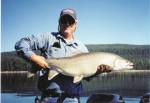 Has
this been enough to get your juices flowing? Are you an
angler who would love to catch a trout as big as your leg?
Do you have what it takes? Remember, if you are willing
to make a commitment, determined to hang in there, and willing
to learn, your odds increase significantly and it is probably
only a matter of time until you feel the adrenaline rush
these big fish can generate. Good luck and go get em. Has
this been enough to get your juices flowing? Are you an
angler who would love to catch a trout as big as your leg?
Do you have what it takes? Remember, if you are willing
to make a commitment, determined to hang in there, and willing
to learn, your odds increase significantly and it is probably
only a matter of time until you feel the adrenaline rush
these big fish can generate. Good luck and go get em.
|